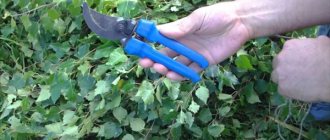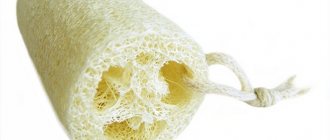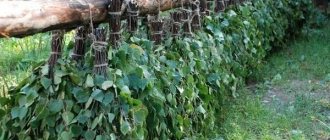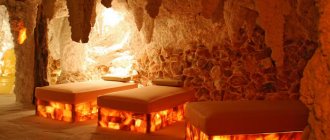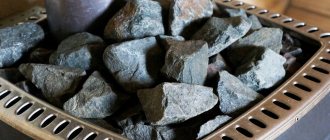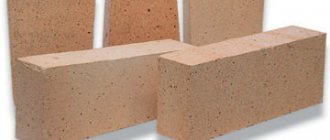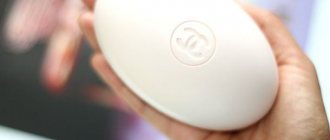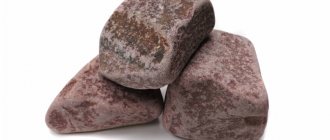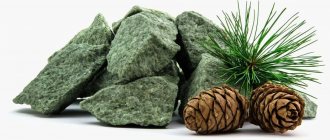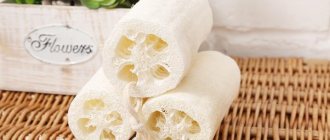I was sure that I had never used or washed a natural bast washcloth. Imagine my surprise when my mother dispelled my beliefs. It was with a bast washcloth that I was washed as a child; this shapeless tow was used for washing in our black bathhouse...
A disheveled bunch of an incomprehensible light brown color, spreading in different directions - this is a real bast washcloth!
In ancient times, people did not stand on ceremony with bath accessories. We didn’t choose everything in the same color scheme, we didn’t choose gentle washcloths, we didn’t look for fragrant soft soap, the shampoos were the simplest.
A little history and purpose
It is not known for certain when the first devices appeared to help cleanse the skin, but already in references in Babylon and Ancient Greece there is information about the first washcloths. Wealthy people used wood or bronze to wash their skin, while poor people used bunches of plants or sand.
Now, a washcloth is already an absolutely necessary household item for every person. Beautifully designed, of different sizes, colors and purposes, they decorate the bathroom and are indispensable assistants in the bathroom.
A washcloth can be made from any available material: natural cotton or chintz, using old terry towels, woven from burlap, and for those who are not looking for easy ways - knitted.
Knitting with knitting needles
You can knit an ergonomic washcloth using knitting needles. To make it you need to prepare:
- 5 knitting needles;
- roll of yarn.
To knit a washcloth for a bath, you need to perform several steps:
- Cast on 8 chain stitches on each knitting needle.
- Knit 4 rows of knit stitches.
- Make a transition to the drawing. Alternate rows of elongated loops with facial loops.
- Knit 4 knit stitches together.
The last stage is making the handles.
Kese washcloth
This washcloth is designed to remove dirt from the skin without the use of scrubs and cleansing gels. If a person has sensitive skin, it is made from natural fibers, silk; for coarser skin, it is made from sheep or goat wool.
Its homeland is the East; from ancient times to this day it has been woven in the traditional way - crocheted. First, you need to knit a handle of 40 loops with two threads, on the third, start knitting cap stitches to the end of the chain - the first handle is ready, we make the second in the same way and fasten its end to the first.
The main part of the washcloth consists of three stitches of 16 single crochets, connected to three stitches of 16 double crochets. The washcloth is ready!
It must be thoroughly washed with water and wrung out well to avoid the appearance of various bacteria and unpleasant odors, since the material used in the base does not dry well and retains moisture for a long time.
Material
Bath accessories for washing the body are made from various materials:
- Ramie is a Chinese nettle whose fibers are used to make washcloths. Ready-made washcloths are medium hard. Suitable for sensitive, rough skin.
- Loofah is a material obtained from pumpkin fruits. Consumable raw materials are dried and crushed. The finished products are rough. They are often used for anti-cellulite massage.
- Bast - fibers of young linden. Individual fibers are knitted into threads, which are then used for knitting. They effectively cleanse the skin of dirt and release phytoncides, which have a positive effect on the respiratory tract.
- Sisal is a tropical plant. Finished products are highly rigid and therefore often used for anti-cellulite massages.
- Linen is a tough material. Cleanses pores well. Before use, the accessory must be watered with hot water.
A separate group includes artificial materials. Their advantage is low price. They are not subject to rotting or proliferation of pathogenic microorganisms.
Burlap washcloth
If you don’t know how to knit or don’t want to, you can make a beautiful washcloth with your own hands using burlap, for this you will need: burlap, foam rubber or sponge, gauze, soap and elastic, and also a piece of cotton fabric.
From burlap you need to cut two identical rectangles slightly larger than your palm, and the same ones for the gauze lining. A holder for a bath accessory is made using an elastic band, assembled like an accordion and covered with fabric. One end is secured in the middle of a burlap rectangle, and the other is sewn to the side.
Next, the burlap is sewn together to form a bag and pieces of soap and a sponge are placed in it to create foam; dried lavender or mint can be added for scent. The washcloth needs to be sewn up. It is ready to use. When the soap in it stops foaming, you will need to rip it open and pour in a new portion.
With long loops
To make the accessory you will need:
- hook No. 4;
- set of polypropylene threads.
Manufacturing process:
- Unwind the required number of polypropylene threads.
- Place two threads together.
- Knit a chain consisting of air loops.
- Close the chain with a ring.
- At the front, insert the hook through the loop of the ring.
- Grasp the thread with your fingers and pull it through the loop.
- Pull the thread through two loops.
- Pull the columns of the second, third, fourth rows through the 1,2,3 loop.
All that remains is to make handles to make it more convenient to use the accessory.
Mesh washcloth
A washcloth can also be constructed from a mesh, which can be purchased in any bathroom department of a large hardware supermarket or at a bazaar.
To do this, you need to form a bag out of it, insert pre-cut foam rubber and fix it on top. The sponge will create a thick foam that can cleanse pores and give freshness to the skin.
Soft or hard?
In the refrigerator and on the brush. Where do bacteria most often accumulate?
Bast washcloths are thin strips of bast that can be tied into a bun or sewn onto a fabric base. The bast itself is made from the inner bark of linden or other deciduous trees. Bast sponges are good for baths, but they are not recommended for use in ordinary bathrooms: the material crumbles and can clog the drain.
Suitable for: bast is a fairly hard material, so it can be used for deep cleansing of the skin. The washcloth can be softened a little by dipping it in boiling water for 10-15 minutes before use.
It is better not to use if you have delicate skin or if you prefer to shower with foam - the bast loofah does not foam well.
Loofah (sometimes spelled luffa) has recently become a popular material for bath accessories. It is a dried vine fruit that has been freed from the skin and seeds. Loofah can be found in the form of a roll, cut into pieces or “packed” in soap.
Who is it suitable for: the loofah is quite hard, so it can be used for peeling and anti-cellulite massage during water treatments.
It is better not to use for people with delicate skin and those who want to maintain a tan longer - a hard washcloth quickly erases the top layer of skin.
Linen washcloths are famous for their durability, ability to absorb water well and lather well. Items for water procedures can be knitted from linen threads or sewn from linen. In the second case, a piece of soap is sometimes placed inside the washcloth.
Suitable for: lovers of foam bathing and allergy sufferers.
It is better not to use for people with particularly delicate skin.
Sisal fiber is also used to weave washcloths, which are quite stiff, but have enviable strength.
Suitable for: those who want to get rid of dead skin on their elbows and heels.
It is better not to use if you have sensitive skin.
Bristle brushes of different sizes and different hardness are suitable for the whole body: with an accessory on a long handle you can scrub your back, small brushes will clean your fingers and feet.
Suitable for: Those who like a good back rub
It is better not to use for those with sensitive skin, or choose especially soft bristles.
Toys will help to accustom your child to water procedures.
For sensitive and problem skin, you should not choose hard washcloths made of sisal, jute, or coarsely knitted washcloths made of polypropylene tape. They will irritate the skin and provoke excessive secretion of sebum.
Polypropylene washcloth
To knit such a bath “helper”, it is enough to purchase the appropriate threads and a hook size 5-6 with a round head. Initially, you need to knit a chain of loops 20 cm long and connect them into a ring.
Next, you need to knit the main fluffy part of the washcloth using the “DC” method and finish with several rows of “SC”, and at the end knit the handles. This way you can knit a washcloth from any material.
Knitting with an elongated loop
Step-by-step knitting instructions:
- Cast on a chain of air loops.
- Knit three rows in a column without making a cape.
- Raise the hook to create an air loop. Make a column without a cape.
- Bring the hook to the next row and make a loop.
- Pick up the working twine with your thumb. Make a ring.
- Move the hook to the starting loop and pull through it.
- Grab the twine with your fingers, pull it through, grab it again and pull it through three loops.
You need to repeat the procedure until you get a canvas with shaggy areas.
Results
If you look at examples of photos of do-it-yourself washcloths in books, brochures, craft magazines or on the Internet, you will see what a variety of these bath items there are. In addition to the original accessory, spending a minimum of time and effort, you will receive a real decoration for the bathroom, an indispensable cleanser suitable for your skin and save money.
Such washcloths can be given as a gift or an addition to a gift, or they can also be sewn for children in the form of various animals or cartoon characters. The child will be more willing to bathe with such a gift.
Knitted bath accessories
To learn how to knit washcloths for a beginner, you need to practice working with knitting needles and threads. You can try three simple schemes:
- Rectangular accessory. Every three rows you need to use elongated loops.
- Round products. To make it fluffy and neat, you need to knit a washcloth with one loop. For originality, you can use threads of different colors that are woven into the base.
- Oval accessories. The scheme is similar to rectangular. Every three rows you need to use elongated loops.

